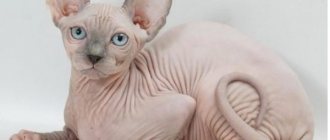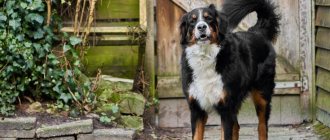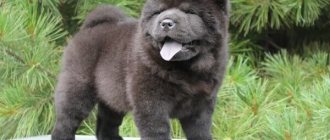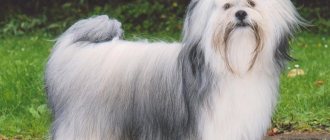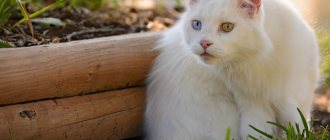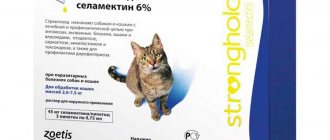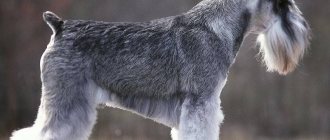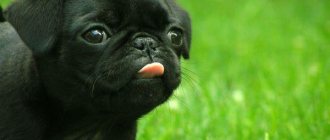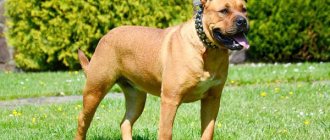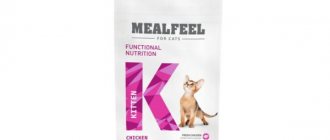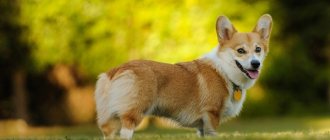The young breed of Bambino cat appeared not so long ago and has not been sufficiently studied. The Bambino is a Sphynx-Munchkin mix that has passed on its distinctive genes: short legs and no hair. Externally, the breed resembles a dachshund.
The period of appearance of the breed was 1999 in the USA, Osborne. She was bred completely by accident, but managed to gain great popularity among cat lovers, especially those who suffer from allergies.
These cats have delicate skin that feels like velor. There are similarities with the sphinx, but bambinos are much more sympathetic to humans due to a number of distinctive qualities. The owners of these pets note their unpretentiousness in food and care, affection, and love for the owner.
Appearance of a cat
The main characteristics of the bambino's external features are listed in the table, but may vary slightly. The most beautiful individual is considered to be the bambino with bright blue eyes and short legs, such as can be found at exhibitions.
Show cat bambino
| Torso | Stocky, strong, barrel-shaped body. Pronounced muscles. Height is from 10 to 20 cm. Average weight is from 2.5 to 5 kg (males are larger in volume than cats). Adults reach 3 kg with a normal balanced diet. |
| Head | The large, lemon-shaped eyes are set wide apart and come in a variety of colors. The ears are straight, fairly large, wide at the base, set far apart. Heart-shaped head. |
| Paws | Short, muscular, folds gather closer to the fingers. Participation in exhibitions is granted only to individuals with short legs. |
| Tail | Long, thin, without folds, in some cases there is a tassel at the end. |
| Wool | There is no hair, in some cases it is on the ears, paws, muzzle, tail or scrotum. The skin color is predominantly light with the addition of gray and pigmentation. |
| Lifespan | from 7 to 15 years. |
Health
The breed is new, so not all the features of these cats have been identified yet. So far, breeders assure that bambinos do not have any congenital pathologies. With proper care, cats are predicted to live at least 12 years.
Tendency to diseases
If not properly cared for, bambinos can easily become infected with infectious diseases. The reason is the lack of wool, which is a natural barrier against drafts and cold air. The animal's skin has a special structure - folded, and has many sebaceous glands. If you do not clean it, inflammation and subsequent suppuration may occur.
Achondroplasia (the presence of short legs) does not affect health and life expectancy. But only if there is no dysplasia. A kitten can inherit this disease from its Munchkin ancestors, for whom impaired development of the hip joint is a typical pathology. Dysplasia can be recognized by unnaturally turned out hind legs and their weakness (they constantly turn in while walking, causing the animal to fall forward or to the side). An animal with diseased joints is susceptible to fractures and dislocations; Due to unstable paws, the load is incorrectly distributed and associated problems with the spine arise (for example, lordosis appears - curvature of the spinal column).
Defects of appearance that do not allow participation in exhibitions
A serious violation of the standard is the presence of long legs (exceeding 1/3 of the height at the withers), as well as hair growth of more than 2 mm (fluff on the ears and tail is allowed). A shortened body and a strong deflection in the spine when the cat is standing are also considered defects that do not allow participation in exhibitions. The display of aggression among bambinos is also not typical, so if a contestant rushes into a fight during an inspection by the commission, he will be disqualified.
History of the breed
A US family in Osborne first saw the strange breed of kitten - the result of crossing a Sphynx with a Munchkin - and were struck by its cute appearance and suede-like skin. The couple accepted the ridiculous kitten into their nursery and took care of registering the new breed. In 2006, the bambino breed was registered with the International Cat Association (TICA) as an experimental breed. The couple came up with the name of the breed themselves.
Munchkin
Sphinx
Breeding in Russia was carried out by a breeding specialist. The breed was registered in the Russian Federation in 2005, called Minskins, but after registration in the international registry they received an American name.
The history of hairless cats
The hairless gene, the result of mutations, has been manifested for several hundred years in a wide variety of cat litters. This phenomenon was not tied to a specific country or breed, and was perceived rather as a deviation from the norm.
The hairless cat and cat, bought from the Aztec Indians in the vicinity of New Mexico by Mr. Shinnik, are mentioned in the works of Francis Simpson. The owner of the unusual pets, although he was unable to prolong their family, presented their detailed characteristics. These events gave impetus to more detailed research and new assumptions.
Gradually, Mexican cats were associated with animals from South America, which were mentioned in the works of the German scientist Jozan Rudolf Rengger back in 1830. He suggested that they were brought from Europe back in the 15th century, and the loss of wool was provoked by a sharp climate change.
In the middle of the 20th century, furless kittens appeared from Siamese in France, but their crossing did not bring practical results. Therefore, the ancestor of the breed is considered to be a cat from Canada, born in 1966.
Gradually, his descendants began to be called sphinxes, for which there are many explanations. Some believe that this was due to the external resemblance to the sculpture of the same name, as well as attempts to convey an unusual aura and extraterrestrial appearance. Others are confident that Egyptian writings describe hairless cats, from whom the graceful image was borrowed when creating sculptures and painting the walls of ancient temples.
Hairless cats have their own unique beauty and grace; they are “aliens” of the animal world. We recommend that you read an article about some of the most beautiful cat breeds that exist in our world, long- and short-haired, and, of course, hairless.
Breed standard
A document regulating the important characteristics and description of a cat breed is called a breed standard. It is used by breeders and breeders to assess the conformity of animals with their pedigree characteristics and by livestock specialists when grading farm animals or by judges of exhibition events when determining the degree of pedigree characteristics.
Zootechnicians are specialists in the issues of breeding, keeping, feeding and caring for farm animals, assessing their benefits and quality in the final product with the least amount of labor and funding.
Valuation is the determination of the productivity of the qualities of animals by assessing them according to a number of characteristics of the breed.
Bambinos have the following parameters specified in the standard:
- head of medium size, elongated towards the top of the head;
- the mustache is completely absent or short in length;
bambino muzzle
bambino muzzle:
- straight skull with clearly visible cheekbones;
- nose straight;
- the neck is powerful, of medium length;
- small chin;
- expressive eyes are located widely apart and have the shape of a lemon;
- the ears are leaf-shaped, set far apart, wide at the base;
- the body is muscular, the legs are short but wide, the shoulders and hips are the same width;
- the shoulders are muscular, the back is slightly curved upward, the chest is round;
- medium or heavy skeleton;
- The length of the shoulder is equal to the forearm, and the lower leg is equal to the thigh;
- paws are oval with long toes pointing forward;
- the tail is long, powerful, smooth, rounded at the end.
Exterior
In appearance, bambinos are very similar to the Canadian Sphynx. They have the same muzzle, identical body structure, and coat quality. Only the length of the limbs differs.
Bambino is often compared to a dachshund due to its short legs and elongated body.
Table: Bambino breed standard
| Sign | Characteristic |
| Torso | The body is medium in size, but elongated. The weight of an adult cat is 2 – 4 kg. Athletic build, well-developed muscles. Wide and massive chest. Big round belly |
| Neck | Powerful, medium length |
| Head | Proportional to the body. Wedge-shaped, round, slightly elongated. Pronounced cheekbones and pads with short whiskers (they may not exist) |
| Eyes | Large and expressive, widely spaced. They are shaped like a lemon. They can be blue or green, less often yellow or gray. The color should be in harmony with the coat. Heterochromia (eyes of different colors) occurs |
| Ears | Large and widely spaced. Wide at the base and gradually tapering towards the ends. Rounded tips |
| Limbs | Short but muscular limbs. The paws are oval in shape, the pads are large and thick. The fingers are long. Hind limbs may be longer than forelimbs |
| Tail | Flexible, resilient and thin. Medium length, should be proportional to the body. Tapers to the tip |
| Leather | The skin is hot to the touch, velvety (like a peach). Covered with folds, especially on the head. Kittens have folds all over their bodies and on their paws. |
| Coat | Bambinos are not actually completely naked. There is a very short, almost invisible undercoat. In some areas of the body (ears, muzzle, tail, paws), soft and thin hair of slightly longer length is allowed |
| Colors | Any colors are allowed, including combinations with white (bicolor, harlequin, van) and color point. But solid colors are most valued |
Thick paw pads are a distinctive feature of the bambino.
Possible defects:
- frail physique, underdeveloped muscles;
- defects in the structure of the tail (kinks, fused vertebrae);
- short body;
- excessive amount of hair.
Photo gallery: bambino colors
The color point color is found not on a milky, but on a gray background
The gray monochromatic body color is very beautiful
White color is the most popular
A black cat is a valuable specimen for breeders
Bambinos have different colored eyes (heterochromia)
Colors and coat
The body of this breed is not covered with hair or has hairs up to 2 mm all over the body or in some areas.
There are clusters of folds on the neck, muzzle, forelimbs, and are barely noticeable on other parts of the body, except for the ears, back and tail. A large number of folds or their complete absence is an indicator of a lack of breed. Below is a photo.
What does a bambino look like according to breed standards?
Colors range from soft pink to dark gray or blue, pigment spots may be present. The eyes always have rich color and brightness.
TOP 10 breeds of hairless cats
To date, nine varieties of hairless cats are known, only three of which were obtained naturally - the Donskoy, Canadian Sphynx and Cohona. They arose as a result of a spontaneous mutation, for which different genes are responsible in each case.
Crossing these representatives with others made it possible to obtain:
- Peterbald from Donskoy and Oriental;
- Bambino from Canadian and Munchkin;
- Levkoya from Donchak and Scottish Fold;
- Minskin from Munchkin, Canadian, Devon Rex and Burmese;
- Elf from the American Curl, and Dwelf with the addition of the Munchkin gene.
Canadian Sphynx
The Canadian Sphynx is the most popular among felinological organizations in all countries, as well as among amateurs.
It can be characterized as follows:
- thick skin is dense and soft to the touch, sometimes has fluff;
- folds on the forehead, neck, and paws smooth out slightly with age;
- muscular pear-shaped body with thin legs;
- the whip-like long tail is curled in a semicircle;
- wedge-shaped head with prominent cheekbones;
- large rounded ears;
- expressive eyes resemble lemons in outline.
Thanks to its unearthly appearance, the Canadian is often called the “moon cat” and is considered one of the most beautiful representatives of the hairless cat.
Also read the article about Canadian Sphynxes.
Don Sphynx
Don cats, originally from Rostov-on-Don, were called “Russian hairless” for some time. A distinctive feature is the presence of different types of hair:
- its complete absence;
- thin “flock” fluff (like a peach), disappearing by two years;
- more noticeable “velor” hairs 2-3 mm long;
- short-haired “brush” with sparse, coarse hairs.
They can also be identified by their medium-sized body with folds in the groin, neck, forehead and paws. The short wedge-shaped head has expressive cheekbones, serious almond-shaped eyes, and large, slightly pointed ears.
More about the Don sphinxes.
Peterbald
The cat, originally from St. Petersburg, has a physique reminiscent of an elegant Oriental, and the skin and undercoat are soft suede. Therefore, he is considered the most elegant hairless representative, and belongs to the group of oriental cats.
The slender body is elongated, fine-boned, has developed muscles and a proud posture, thin and long limbs. The muzzle is narrow, high cheekbones, with slanted green or blue eyes and huge ears. Folds are present mainly on the scalp, and the fur can be of different types, like the Donchak, but the color is often dark.
Also read the article about the St. Petersburg or Neva sphinxes.
Ukrainian Levkoy
In Kyiv, as a result of crossing, a fold-eared kitten without hair was obtained. Its muzzle has a very unusual structure: a wedge-shaped head with five edges, an elongated neck, slanting green eyes, and, as a highlight, curved ears in the shape of a leftover flower, which is where the name came from.
This cat is flexible and graceful, with a slender body and limbs. It is acceptable to have a small fluff, as well as not too deep folds on the stomach, head and neck.
Read more in the article about Ukrainian Levkoys.
By the way, did you know that Levkoi are prone to aggression if they are not given enough attention? Read about this, as well as about other cat breeds that may turn out to be evil, on our portal Mister Cat.
Elf
Unlike the previous representative, the Elf has rounded ears that are curved not forward, but backward, which is reminiscent of mythical characters. Cashmere folded skin without hair may have wool tufts on the paws.
The body type is typical for hairless cats. The head is wedge-shaped, without vibrissae, with slanted almond-colored eyes.
This cat was bred in 2006 and has not yet become widespread, so it is found in only a few nurseries in North America.
Dwelf came out very similar to him, in whose gene pool there are also traits of the short-legged Munchkin. Short limbs, ears curved to the back of the head and almost complete absence of fur make his appearance very cute and funny. But this breed appeared not so long ago, in 2009, so it is still experimental.
Dwelf
More interesting and educational information about Elves on the Mister Cat portal.
Bambino
With a long body and short legs, the Bambino closely resembles a dachshund. The rounded muzzle with large lemon-like eyes takes on a slightly childish expression, which explains the name. And the ears are large, like all hairless ones, slightly tapering towards the tips. The skin is completely covered with soft folds and has no fur.
These cats themselves are small, weighing no more than 4 kg. And, despite their peculiarity, they are quite playful and agile.
Read about Bambino cats.
Minskin
Another experimental variety is Minskin, which is very similar in appearance to Bambino. Therefore, many experts agree that it is only an analogue of the one obtained earlier. It can be distinguished only by its short fur, slightly longer in the area of the ears, paws, tail and muzzle. Only the stomach always remains bald.
Cohona
The Hawaiian Hairless is one of the few cats whose hairlessness gene was obtained naturally. It is also called rubber because of the characteristic skin that resembles wax to the touch. This is not visible in the pictures, but you can verify everything in person.
Due to the mutation, the cat’s fur is completely absent, as are the hair follicles in it. Therefore, she cannot have a mustache, eyebrows or other vegetation. The folds are very expressive on the cheeks, forehead, neck and paws. The eyes are almond-shaped.
Character
Bambino is translated from Italian as “child”, this definition is completely suitable for these pets. The activity and curiosity of bambinos knows no bounds; they are very friendly with their owners, guests, other animals (cats, dogs, rats), and love children.
Cats are companions on any journey with their owner, they easily endure travel, become strongly attached to a person, remain loyal, feeling as comfortable as possible in his presence.
They are ready to explore everything around them, be active for a long time, run well, but jump only short distances.
Character and behavior
The character of the Bambino matches its name: cats of this breed are infinitely kind and devoted to their owners. They have no desire to hunt at all, therefore, no matter who lives in your house - a chattering parrot, a panting hedgehog, a restless hamster, another cat or dog - the bambino will quickly find a common language with him. Do not let your cat walk alone: he is in danger in the form of unfriendly animals. Bambino will not be able to repel an opponent even of his own size, so do not let your pet out of sight.
A smart and quick-witted bambino quickly learns all the rules of the house in which he lives. He runs to his litter box not only when he needs to, but also when he feels sick, so buy a container with low sides so that it is convenient for him to climb into it.
They love people and company, feel extremely uncomfortable alone and begin to break into closed doors with all their might. These are eternal children: they need constant attention, affection, lots of toys and control. Curious cats can jump from a height, stick their nose into a hot oven, try an electric wire on their teeth - in general, they have plenty of worries. Sometimes their attention is attracted by things that other cats are not interested in, so hide small and dangerous things away.
Allergy
Bambino is an ideal solution for those who have family members who are allergic to cat hair. Such a cat either has no hair or has small hairs that do not affect the allergy receptors.
In rare cases, irritant reactions may occur to the protein secreted by the breed, which is produced on the surface of the skin by sweat glands or during urination.
If you don't pay enough attention to caring for your cat's skin, it may begin to peel off, which will stimulate the receptors, causing sneezing and itching on the skin and eyes, especially if the person in contact has an allergy to dust.
Cat fluff and hair cause allergies
It’s easy to find out whether a bambino will cause allergies: just spend about two hours communicating with it.
Content Rules
Artificially bred cat breeds always require special care and careful attention to their person.
Nutrition composition
A cat's digestive system needs food with a balance of nutrients. In addition, bambinos inherited from sphinxes not only wrinkles, but also a tendency to overeat. You need to feed the animal according to a schedule, and never overfeed it.
The main component of the diet should be meat or poultry. Food should be given to the cat scalded, with the addition of grated carrots. You can cook porridge, but you should include them in your diet gradually and only in the amount of 1/5 of the total diet.
Cats definitely cannot:
- fatty, salty foods;
- milk, kefir;
- legumes;
- sweets, chocolate.
If it is preferable to give your pet dry food instead of natural food, then you should choose brands that produce products for Sphynxes: Royal Canin or Natural & Delicious. Choose food according to your pet's preference.
Bambino video
How to feed a bambino
Approximate diet for a bambino kitten or adult. Feeding variations with Royal Canin food.
Diet of dry food without additional, natural food per day for a kitten up to one year:
- 2-3 months, 52 grams/day
- 4-6 months, 63 grams/day
- 7-9 months, 65 grams/day
- 10-12 months, 56 grams/day
Dry food ration per day for an adult cat from one year of age:
- 3 kilograms, 56 grams/day
- 4 kilograms, 69 grams/day
- 5 kilograms, 81 grams/day
Appearance care
Bambino hairless cats cause certain problems.
- Sensitivity to temperature conditions. Their delicate body is prone to burns. And also, if a person is cold, then the cat will be cold too. This can be solved by regulating the temperature and clothing for the cat. You can knit a small bambino sweater or buy a similar one at the pet store. The cat's bed should be soft and insulated.
- Cats with long hair do not have problems with sweating, but hairless bambinos face similar difficulties. Sweat is not absorbed into the fur, but remains on the surface of the skin, where it then mixes with dirt and gets clogged into the folds of the skin. It is advisable to wipe the cat's face three to four days a week with a damp cotton pad. You will need to bathe your cat regularly. To do this, you need to tame your pet from an early age to water procedures in warm water with a special cat shampoo. You can give your cat a treat after a shower to reinforce positive associations and make subsequent cleaning processes easier.
- Nails should be trimmed as they grow in size using nail clippers, which can be purchased at a pet store.
Maintenance and care
When purchasing an active bambino, it is better to provide him with plenty of space to play and run around. He doesn't need a special sleeping place. It is much more important to pay attention to his playground, which can be represented by a labyrinth with frequent and low steps.
Play tunnels must have a long distance, but move to a height carefully, gradually, and it is also advisable to create additional safety from falls or the cat’s desire to jump from top to bottom, for example, by laying a soft landing pillow under the hole.
If the bambino frequently jumps to heights, you should provide an additional object so that the cat can jump to the target without injuring bones and joints.
Grooming
This care includes ear care, eye care, including nail trimming and skin care.
- It is recommended to clean the ears weekly using a cotton pad soaked in a special solution (purchased at a pet store). Using circular movements, dirt, grease and shine are removed from the ear.
- The eyes are washed with chamomile; it is sold in the pharmacy in the form of a packaged flower collection. Chamomile soothes the delicate skin around the eyes, clearing away impurities and secretions and protecting against harmful bacteria.
- It is enough to wipe the skin with baby lotion to remove dirt and moisturize it, preventing peeling.
Bambino grooming includes cleaning the ears, eyes, skin care, and trimming the nails.
The pet's delicate skin requires additional care.
Moisturizing the skin of a bambino is not a difficult procedure compared to grooming a fluffy cat.
Bathing a cat
Bathing procedures are carried out once a month to ensure the cat is comfortable and maintains hygiene. Pets need water treatments, because they also get dirty when they play, eat, sleep, lick themselves, and relieve themselves. Bambino skin is very delicate and there are specialized shampoos for this breed that are designed to care for hairless skin.
The shampoo is applied using a soft sponge or by hand in warm water. The area of the ears and muzzle is washed with a cotton pad or a small sponge, so as not to cause discomfort and unpleasant sensations in the cat from water getting into the eyes, nose, mouth, and you should be careful with the ears.
Bathing a bambino cat
A hairless cat loves warmth, so clothing for such cats often helps solve the problem of temperature control in the house. They treat clothes calmly, even comfortably, feeling warm and soft.
Eating bambino
These cats do not suffer from overeating due to their activity and strong mobility, are not susceptible to allergic reactions, and have a good metabolism.
You can feed the bambino the same food as other cats: ready-made dry or wet mixtures, natural food.
Natural nutrition should include boiled meat, poultry, rabbit meat, vegetables and grains.
Adult cats eat 3 times a day, kittens - up to 6 times.
Among the purchased feed mixtures, the following manufacturers are distinguished: ACANA, Royal Canin, Pro Plan, Natural amp, Hill's Science.
Royal Canin specialized food for sphinxes and bambinos
You can use food for sphinxes. The listed brands have already taken care of balancing the nutritional value with mineral and vitamin complexes; the food is offered depending on the weight and age of the cat; details can be found on the packaging in the directions for use.
Character of the breed
Bambino owners are proud that their pets are forever kittens. This formulation originally arose due to the cat’s small size and disproportionately small paws. However, there is another factor that makes this breed so attractive to people. This is their outgoing and lively nature.
Bambinos are very active cats. They prefer to run, climb, and jump on surfaces. Their favorite leisure activity is playing. The undoubted advantage of the breed is its non-aggressive behavior and suppression of hunting instincts. Therefore, these animals are considered excellent family companions. Bambinos are friendly towards children and can easily tolerate increased tactile or emotional contact.
The cat will get along with other animals in the house without any problems. A dog, cat or any other human friend will make contact with the new non-conflict tenant. The short-haired companion will not hunt birds and rodents - he is not interested in this.
It must be remembered that due to their activities they tend to experience boredom. Providing a cat with various toys is an important task that every owner of such a pet faces. The more varied and attractive the toys, the greater the chance of not seeing your apartment in disarray upon arrival from work.
Various balls are suitable for Bambino, the cat will vigorously chase them around the apartment. If your cat prefers passive entertainment, then you can choose a classic mouse toy. They come in different sizes and are made from different materials. Choosing an option for your pet will not be difficult.
Health and illness
Dermatitis or rash on the skin of the Bambino.
The bred and registered breed appeared as a new one not so long ago. It will take many more years for a complete description of the diseases to be collected, but some features have already been noted.
- As a result of poor skin care, dermatitis or minor peeling may appear due to a lack of vitamins, temperature changes, insufficient nutrition or lack of hydration.
- Individual manifestation of allergic reactions, which is quite rare, but quite possible.
- The occurrence of tumors without sterilization and constant estrus in a cat without subsequent pregnancy.
- Hip dysplasia in rare cases due to structural features.
- Hereditary diseases: lordosis and hypertrophic cardiomyopathy.
Diseases
Bambinos are not long-livers: today, since the breed is still very young, the upper limit does not exceed 12 years. But everything can change: breeders are confident that if the breed is rid of hereditary problems, individuals will be able to live several years longer.
We managed to overcome the first problem, or rather, learn to cope with it with minimal losses. We are talking about hypertrophic cardiomyopathy - a pathology of the heart muscle that leads to the sudden death of a pet at a very young age. Most often, the disease occurs in males.
The animal becomes lethargic, refuses to play and does not want to run, it develops shortness of breath and coughing, fainting, and paralysis of the limbs. This pathology was inherited from the Canadian Sphynx and, unfortunately, it is impossible to cure it. But improving the quality of life with the help of drug therapy and regular medical supervision is quite possible.
The second problem also causes bambino owners a lot of trouble: weak immunity. Breeders especially recommend that owners not allow pets to come into contact with street animals, and also carefully plan the menu and ensure that the animal does not become hypothermic.
Expert opinion
Dusheba Vera Ivanovna
In 2010, she graduated from the Moscow State Academy of Veterinary Medicine named after K.I. Scriabin with honors, specializing in veterinary medicine. I regularly attend veterinary conferences, congresses, and webinars.
Many felinologists believe that the use of immunomodulators is not justified: they are expensive and do not have the desired effect. In any case, only a doctor should prescribe them.
Naturally, you should not refuse preventive vaccinations: against rabies, panleukopenia, calcivirosis, and the like. These diseases can lead to the death of your pet, and you can easily introduce pathogens into your home on your hands or the soles of your shoes. Please remember that you cannot:
- Use low-quality vaccines or expired vaccines;
- Vaccinate cats weakened after illness, exhausted, wormed (with the exception of extreme necessity), pregnant and lactating females, and babies;
- Individuals who have been in contact with suspicious and sick animals.
Vaccination against shingles is not mandatory, but is advisable if your cat lives in the same room as a dog.
Female bambinos successfully give birth and raise their offspring. Cats reach sexual maturity at 7-8 months, but it is better to introduce them to a cat within a year and a half. Usually no more than 4 kittens are born in a litter (every 4th embryo does not survive when mating such miniature individuals). If you do not plan to breed, have your cat spayed. “Empty” heats often lead to the formation of tumors.
Pregnancy and childbirth
The best age for the first mating is 1.5 years. Bambino offspring average up to 5 kittens. There are no difficulties in pregnancy; cats cope well with childbirth and feeding.
The owners' responsibilities include providing quality food and creating conditions for caring for the kittens. The cat will make it clear that the baby's bed is uncomfortable when it begins to move them to another place. It is important to pay attention to how the cat reacts to the prepared kitten bed before the birth itself.
During your first pregnancy, you should be monitored by a veterinarian.
History of the origin of the sphinxes
Sphynxes are one of the oldest cat breeds. There is evidence that they existed in ancient Egypt, when the white, blue-eyed sphinx guarded sacred places. The ancient Aztecs also had cats without hair; resourceful people used them as living hot water bottles.
Ancient breeds of hairless cats disappeared for various reasons, therefore, we can say that modern Sphynxes were bred artificially. For example, in the USA at the beginning of the 20th century, there was an exhibition where the Mexican hairless cat was shown - the closest relative of the ancient hairless cats. Unfortunately, the Mexican hairless disappeared completely by the thirties, because they could not leave productive offspring.
Hairless kittens can appear in furry cats, regardless of their breed. In 1938, biologist E. Letard from France began studying mutations that were observed in hairless kittens from a Siamese cat. In parallel, hairless cats had already been studied in Scandinavia and England, although these were only studies and not attempts to recreate the ancient breed.
The breed dates back to 1966, when another hairless kitten appeared in Canada from an ordinary domestic cat. The kitten was named Prune and was bred with its mother, resulting in both furry and hairless kittens. It was Prune who was crossed with his relatives in order to get as many hairless kittens as possible. However, the breed had not yet been formed, and the population was small. In addition, the kittens had weak immunity and often died.
The story of the Sphynx could have ended if in 1975 a hairless kitten had not appeared in Wadena from an ordinary short-haired cat. The kitten was ironically named Epidermis. Afterwards, a hairless cat was born there, and both individuals were placed in a nursery. This is how the Sphynx breed began - they successfully reproduced and gave birth to hairless kittens.
Kittens
Bambino babies are very similar to Sphinxes, but as they grow older, they change and the number of folds decreases.
Bambino leather is velor, very soft. This is one of the advantages of the breed that Sphynxes do not have.
Kittens are fed 6 times a day; after 1.5 years, feeding becomes like that of an adult cat.
Bambino kittens
Breeders prepare bambino kittens for sale by vaccinating the kittens and performing anthelmintic procedures in order to give a completely healthy baby to a new home. Kittens are ready to leave their mother at the age of 4 months.
Breeding
For the first mating, they are looking for an experienced cat. This is done to ensure that the situation is not overly stressful or nervous. Partners must be vaccinated and dewormed (free from worms).
At what age should you give your pet for the first mating?
For the first time, a cat begins to go into heat before the age of one year. At approximately 7-8 months, the animal’s body is ready for fertilization. The optimal age for mating starts from one and a half years.
Advantages and disadvantages
The disadvantages of the breed include:
- high price for kittens from the nursery: from 40 to 400,000 rubles (depending on the package of documents, gender and peculiarities of skin and eye color);
But connoisseurs of luxury can note this feature, on the contrary, as an advantage, because there are fewer owners of such an interesting breed; not everyone can afford to buy an exotic pet.
- do not react well to the cold, freezing without clothes or in a cool room;
- require skin care, it is especially necessary to clean the folds.
Advantages:
- active and friendly;
- have a good appetite;
- hypoallergenic;
- Excellent companions for the owner: they can easily endure trips, travel, love and are not afraid of children, get along well with other animals.
Buy bambino cats
In order to buy a bambino kitten, you first need to find one. In Russia, this is quite difficult to do, since there are few nurseries involved in breeding this rare breed, most of them are located in Moscow and the Moscow region.
The price of bambino cats in Russia starts from 50 thousand rubles - for a pet-class animal (this means that it is castrated or sterilized, and you are prohibited from breeding and crossing the pet). For a premium class bambino kitten, which can be presented at exhibitions and further bred, you will have to pay an average price of 250-300,000 rubles.
Due to this pricing policy and the rarity of the breed, many speculators have appeared on the market offering to buy Bambino kittens at a low price. It happens that this is due to the lack of documents and pedigree, but most often sellers slip in Sphynx kittens, which at a young age are very similar to bambino.
Breeding
Crossbreeding two adult bambinos on your own is unacceptable; it is dangerous due to the appearance of mutations in kittens. The breeding of this breed is always accompanied by professional geneticists and felinologists. You can purchase kittens of this breed in nurseries: Mirmagnificent (Sochi, Russia), Shococats, Joser (Moscow, Russia); LilNudists, Forest For Film, Kyty Kittens (USA).
You can buy a bambino kitten in a nursery in Moscow or Sochi
It is not safe to buy bambino kittens by hand. The point is not only that they may have mutations or diseases, but that scammers often pass off the Canadian Sphynx as a bambino, which significantly affects the price of the animal. In this case, you can overpay several times, and the cat will not grow up to be what you expected it to be.
Catering
Accelerated metabolism is another feature of bambino cats, but this also poses a danger, namely gluttony, which can lead to obesity and related problems. Therefore, do not react to your cat’s plaintive meowing and paw slap on an empty bowl: feed her exactly as much as required by her weight, and do not indulge her with snacks between main meals.
Keep bowls clean. They need to be washed after every meal and the water changed 2 times a day in the mornings and evenings.
Kittens up to 4 months eat 6 times a day, over six months - 3-4 times, over a year - at least 3 times.
At first, feed the baby the same thing that the breeder fed him, and introduce new food gradually. Whether you switch it to natural food from industrial food or vice versa - it doesn’t matter, the main thing is that the products must be of high quality, without chemical additives. What is suitable for humans is not suitable for animals, so remember a few nutritional rules.
Natural products
Bambino cats, like other cats, should not be fed from your table. Human food - fried potatoes, rolls, fatty soups, etc. - causes serious health problems in animals. But they don’t taste sweets at all, they can eat it with great appetite and become seriously poisoned in the future.
The basis of natural nutrition is lean meat, dairy products, cereals, vegetables and eggs. Meat (beef, veal, rabbit, turkey, lamb) should first be kept in the freezer for a couple of days, and scalded with boiling water or boiled before serving.
It is mixed with porridge cooked in water (oatmeal, rice, corn, buckwheat, millet or semolina), adding some vegetables (zucchini, pumpkin, carrots, beets, beans), fresh herbs (parsley, dill, green salad) and a spoon of any vegetable oil (sunflower, olive, flaxseed).
3-4 times a week the cat should be given dairy products: hard unsalted cheese, cottage cheese, yogurt, fermented baked milk, natural yogurt. From time to time, meat can be replaced with offal, stewed chicken hearts, liver, gizzards, ground into minced meat. The eggs are boiled and only the yolk is given from chicken eggs, whole quail eggs.
The following products should not be given:
- Salted (including pure salt), smoked, pickled, fatty;
- Condiments, sauces, spices, seasonings, aromatic herbs;
- Offal, lard, bones (including boiled chicken, especially dangerous);
- Potatoes, tomatoes, eggplants, fruits (exception: apples, pears, melons and watermelons);
- Human drinks;
- Dog food.
Recommended food
Economy class cat food: Wellkiss, TerraCot, 365 days.
Premium: Zoogurman, Mnyams, Native food.
Super premium: Pronature Life, Summit, Vet Life.
Holistic: Orijen, Power of Nature, Wildcat.
Below are recommended super-premium foods. Links with the names of the food are clickable, on them you can, within our website, read the descriptions of the food and read reviews from owners of Bambino cats.
| Premium | Super premium | Economy |
| Sirius | Leonardo | Perfect Fit |
The vitamin and mineral complex is selected taking into account the individual needs and parameters of the animal (age, weight, activity, concomitant diseases, etc.). Popular: “Agrovetzaschita”, “Farmaks”, “8 in 1”, “BEAPHAR”, “Doctor ZOO” can be bought at any veterinary pharmacy. In addition to vitamins, the cat should be given dry brewer's yeast in courses, according to the instructions.
Interesting Facts
Bambino on a walk in clothes
- The peculiarities of friendly communication are associated with the lack of a hunting instinct, which is why they are often kept together with representatives of rodents and birds.
- Any cat is afraid of children and does not let them near them, but bambinos are recognized as the best friends for children.
- This breed has no whiskers at all or is too short in length.
- Skin without fur is susceptible to peeling, requires additional care, and is also afraid of direct sunlight and precipitation when walking, so it must wear clothes.
- The bambino breed has been included in the Register of Rare and Exotic Animals since 2006 by the Rare and Exotic Feline Registry Association. And TICA included this breed in the experimental group until several generations confirm the stability of the hereditary traits.
Mr. Cat recommends: personality traits of hairless cats
All cats without fur have a warm disposition and a pleasant character. Whether this was the result of experiments, or whether it was inherent in nature, many people compare such pets primarily with dogs, always faithful, devoted and affectionate. Very quickly becoming attached to the owner, they have a hard time with a change of environment or a long separation, or constant loneliness.
These are sociable cats, very smart and inquisitive. Some of them are able to carry small objects and are easy to train. They understand human speech well and the tone in which their owners speak to them. They love affection and give it in return.
The good nature of pets will come in handy if there are small children or other animals in the house. They do not show aggression, so they will never offend children or bite or scratch.
Read about the best cat breeds for children.
Moreover, there is an opinion that they have a positive effect on people’s health and psyche.
Hairless breeds and their origins
In the last century and this century, hairless kittens have appeared from time to time in the litters of ordinary cats in different parts of the world. Some of these kittens later became the founders of new breed lines.
Hairless breeds that exist today:
- Canadian Sphynx;
- Don Sphynx;
- Petersburg Sphynx or Peterbald;
- Ukrainian Levkoy;
- Elf;
- Bambino;
- Dwelf;
- Kohana or Hawaiian hairless;
- Lykoi or werecat.
Breeders did not contribute in any way to the appearance of the first hairless cats, but merely consolidated a natural mutation that spontaneously arose in them. This anomaly does not pose a direct danger to the health of animals, and is not genetically linked to any internal pathologies. That is, the health of hairless cats is just as good.
Of course, they are not suitable for living in the natural conditions of northern latitudes, and you will not find them among strays. In countries with cold climates, these are exclusively pets, and breeders carefully protect them from hypothermia.
There are suggestions that in ancient times hairless cats lost their hair due to the climatic conditions of the regions in which they lived. Historical centers for the appearance of their populations were located in areas with a hot climate, where wool was not only not needed, but even got in the way.
Munchkin
Perhaps the most popular breed of cats with short legs. If we talk about the appearance of such pets, they have much in common with ordinary (wireless) purrs - proportional shape of the ears, round head, varied colors.
The Munchkin breed originated in America, where it was registered in the 90s of the twentieth century. These kittens come from a street cat that was found on the street in the 80s of the last century. Initially, there was an assumption that the cat had a genetic disorder, but after a while she brought babies with short legs, as a result of which the breeding of the pet breed began.
Bambino
Many people find hairless breeds too scary. However, you will undoubtedly fall in love with such a kitten with short legs. The Bambino breed is the result of crossing a previous pet breed (Munchkin) and the Canadian Sphynx.
The name of the breed itself is translated as child (Italian). As adults, Bambino cats weigh no more than 3 kilograms. The main distinguishing feature of such pets is the ability to sit on their hind legs.
The Bambino breed, despite its small paws and lack of hair, is distinguished by good health. The only thing that is important to take into account is that as a result of the lack of fur, kittens have difficulty withstanding the cold. Therefore, if it is below +21 degrees in the room or outside, it is advisable to put a jacket on the kitten.
Sphinx - description of the breed
In fact, sphinxes are not completely devoid of fur: their skin is soft and velvety to the touch. The Sphynx's fur is so short that it is almost invisible. Some Sphynx breeds have some hair on their face or paws, although most Sphynx breeds appear completely hairless. Also, these cats do not have whiskers.
Today there are three generally recognized breeds of Sphynx, which are registered by the Association of Cat Fanciers.
These include:
- Canadian Sphynx. This breed has been around for 60 years. The body of the Canadian Sphynx has inconspicuous fluff and many folds of leather. They have large expressive eyes and large ears. The body is smaller in size than that of a normal cat;
- The Don Sphynx was bred in Rostov-on-Don. They are quite large and have a lot of folds. The body is more massive and short - they are very reminiscent of an ordinary domestic cat without hair. Sometimes a small amount of soft fluff is allowed on the bodies of Don Sphynxes, which curls into curls;
- The Peterbald or Petersburg Sphynx is a breed obtained by crossing with graceful Oriental cats. Thanks to this tandem, the breed turned out to be very elegant: an elongated head, narrow eyes and long ears. The body is refined, elongated. Peterbalds may have a small, smooth coat.
The Sphynx cat continues to change and improve. So far, the most popular and stable are the Canadian Sphynxes. All sphinxes have well-developed muscles, which makes them, even with all their elegance, quite strong animals. The tails of sphinxes are also completely devoid of hair, and are always slightly curled into a spiral at the end.
Interesting facts about hairless breeds
Some interesting facts about hairless cats:
- Sphynx kittens are often born with fur , which disappears as they grow older. But, in fact, their body is covered with velvety, short fur, so stroking is accompanied by pleasant tactile sensations.
- Sphinxes know how to smile , and quite nicely. A smiling sphinx greeting its owner from work is a common occurrence.
- There is an opinion that hairless cats have more folds on their body compared to regular cats. In fact, this is not so, it’s just that the folds are not visible under the fluffy fur. The exception is representatives of the Kohana breed.
- Hairless cats are not hypoallergenic , as many people think. People are allergic not to hair, but to a protein contained in the physiological secretions of animals.
- The length of the ears of the Canadian Sphynx is 5-6 cm.
- Sphynxes are extroverts , they love to be in the center and meet new people.
- These cats have amazingly dexterous fingers , with which they expertly grasp various objects.
- The body temperature of hairless cats is only 0.5 °C higher than that of cats with fur. For comparison, for ordinary fluffies it is 37.5-39 °C, for bald ones it is 38-39.5 °C. This is due to high energy metabolism, and this is why hairless pets absorb 2 times more food, which helps them maintain body heat.
Price and where to buy a bambino kitten
The cost of a bambino kitten is high. Although the breed still has experimental status, it is divided into classes.
Pet-class kittens are the cheapest. They are sold already sterilized and will not take part in breeding. The defects are minor and an inexperienced person may not notice them. This will be a great housemate.
global $ads_google; //data-ad-slot=”2475549904″ $ads_google = empty($ads_google) ? false : true; ?> if ($ads_google == false) {?>
$ads_google = true; ?> } ?>
If you want to go to exhibitions, buy a show-class baby. And to breed the Bambino breed, you need to buy a Creed-class cat.
There are nurseries in Russia where you can buy a bambino kitten at a price of 45,000-60,000 rubles
.
The animal must be completely healthy at the time of the transaction, treated for parasites and already vaccinated according to schedule. Breeders share information about living conditions and medical research. All information will be reflected in the cat metric.
How to name kittens
Everyone knows the difficulties of coming up with names. It also happens that a name was invented, agreed upon by all household members, but when you look at the cat it seems that it’s not right, something else is needed.
A bambino boy or girl can be called a nickname with an Italian sound. Why not, the first owner named the breed in Italian?
We are sharing a list of beautiful names for the hairless, short-eared short-legged one!
Nickname table
| Girl | Boy | ||
| Tella Gata Marie Amanda Vixey Sigma Fiona Cameli Brada Emily | Elina Greya Lulya Nyama Mouse Drop Daria Sandra Nigma Plusha | Velvet Zephyr Taisan Schwartz Valli Smiley Icek Altair Love Lenin | Felix Mikey Uchar Prime Shek Anteo Weiss Dodger Aylan Largo |
Caring for a Sphynx cat
The obvious difference between Sphynx cats and other cats is the complete or almost complete absence of hair. At first glance, this should have made them easy to care for. There is no need to comb your pet, give it malt paste, the fur does not fly all over the apartment. In fact, caring for a Sphynx is somewhat more difficult than caring for an ordinary cat.
Rub your eyes
The eyes of sphinxes lack natural protection in the form of eyelashes. Because of this, their cornea is intensively washed with tears. A tear mixed with dust oxidizes in the air and a brown jelly can be seen in the inner corner of the eye. This discharge should be removed with a damp cotton pad every day.
This is the Don Sphynx. The eyes are deprived of natural protection in the form of eyelashes
Clean ears
Naked-skinned sphinxes produce a large amount of skin lubricant. And just as actively, brown secretion is formed in the ears. In a healthy cat, dark brown discharge is not accompanied by itching or redness of the skin. They are removed using a special softening lotion and a cotton pad.
The Sphynx's ears must be kept clean.
Bathe
If the Sphynx is not bathed, brown skin discharge will remain everywhere - on the bed linen, on the white windowsill, on the furniture. In addition, the specific smell that comes from hairless cats intensifies.
You need to wash your Sphynx with a special shampoo for hairless cats. Human products are not suitable because they disrupt the pH of the skin.
Ukrainian Levkoy in the bath (he is not happy about bathing)
The frequency of bathing is determined individually. Some unspayed cats require frequent bathing - every 2 weeks. Other cats can be washed once every 1-2 months, and some even once every six months. It all depends on the desire of the owner and the health of the skin. Typically, a cat is bathed when a specific smell becomes too strong.
As for the smell, every Sphynx owner has his own opinion about what his hairless cat smells like. Odors include cheese, boiled potatoes, mushrooms, popcorn, cooked rice and even iodine. Some cats smell so sweet that their scent is reminiscent of milk and cookies. Some are neutral, that is, leather, evoking associations with a sheepskin coat. The smell intensifies when the cat warms up under a blanket or near a radiator.
Sphynx bathing
Care for claws
To prevent your pet from scratching you, the furniture, or itself, it is better to trim its claws with a special nail clipper. It is enough to do this once every 2-3 weeks. In addition, you need to ensure that brown discharge and dirt do not accumulate in the claw bed (the fold of skin around the claw).
Nails are not trimmed
And this sphinx had a manicure done. Claws grow quickly.
Protect from cold
Completely devoid of hair, sphinxes are not adapted to our climate. But in a city apartment they are quite comfortable, if you do not wrap the kitten in clothes from childhood.
The Sphinx must be provided with a warm house, a bed or a hammock on the radiator.
The Sphinx needs his own house!
In the cold season, you may also need clothing - a soft sweater is most comfortable.
Dressing up naked cats is a special pleasure
There is an opinion that sphinxes climb into people’s arms precisely in search of warmth, and not out of great love. And a naked cat will definitely want to sleep with you under the blanket!
Mur-mur of tenderness - the Canadian Sphynx cuddles up to its owner
How to choose the right kitten, cost
It is recommended to buy kittens in nurseries; in this case, you will receive documents with a pedigree and a medical card with a list of previous diseases and vaccines. When choosing a kitten, focus on its parents and living conditions. If the breeder does not take care of the wards, this can cause diseases in the future. Assess your baby's appearance, behavior and playfulness.
The cost of purebred pet-class animals starts from 10 thousand rubles, a show-class animal can be found on sale for 150 thousand.
Estimation of breed characteristics
| Adaptability: |
| Shedding level: |
| Social need: |
| Grooming: |
| Ease of care: |
| Attachment to family: |
| Hair loss/shedding: |
| Predisposition to diseases: |
If sphinxes do not seem very attractive, it is worth getting acquainted with representatives of the bambino breed. They appeared recently, but their exceptionally cute appearance and excellent character quickly make them popular. When making a purchasing decision, you need to find out everything about the breed of these hairless cats so that the surprises are only pleasant.
Sphinx health
The absence of fur creates a feeling of fragility and defenselessness. Fortunately, this impression is wrong. With good care, sphinxes are long-lived, with an average lifespan of 15-16 years.
It is recommended to adopt a kitten at the age of 3 months – after the second vaccination. Annual vaccinations should not be neglected, even if the pet does not leave the apartment.
Sphynxes can be real long-livers
All bare-skinned breeds are young, but information has already been accumulated about some hereditary diseases of sphinxes. It should be remembered that Canadian and Don Sphynxes are completely different breeds. And their genetic diseases are also different. You can read more about the Canadian Sphynx in a separate article.
